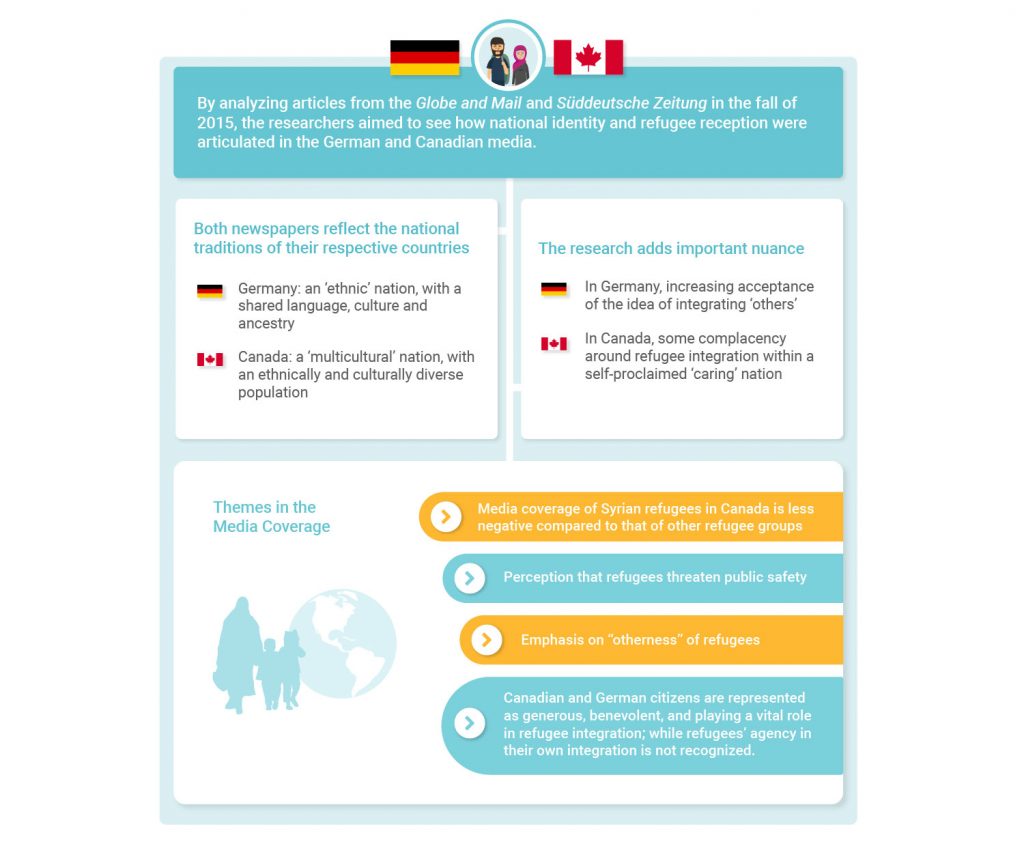Refugee Reception and Perception in Germany and Canada
Researchers: Elke Winter1, Anke Patzelt1, Verena Schmid2, Mélanie Beauregard1, Charlotte Murret-Labarthe1, Bianca Stumpf 1, Carsten Saremba3, and Georg Mildenberger2, 4
Affiliation: University of Ottawa1, University of Heidelberg2, University of Potsdam3, and the Centre for Social Investment4
Research Partner: The Refugee Hub
Keywords: Canada, Germany, refugees, asylum, Syrians, media analysis, newspapers, discourse, public opinion, nationalism, national identity, integration
Jump to: Full Infographic, Methodology, Findings, Publications & Reports
Summary
Objective: This multi-year study explores media representations of refugees and refugee-related issues in Canada and Germany, from the initial arrival of Syrian refugees in 2015/2016, to public claim making for and against refugee newcomers, to issues of long-term integration in 2020.
Justification: Since the start of the Syrian “refugee crisis” in 2015, migration has become an important issue of contention in the public space, with multiple and diverse actors engaged in defining ‘citizenship’ and its relation to perceived “outsiders”. Issues of identity and integration are heavily shaped and communicated through mainstream media. This project collects media data to better understand how refugees are received and perceived in Canada and Germany.
Practical goal: To understand refugee perception in the media and public opinion and how these influence refugee integration into the host community.
Primary audience: Academics, service providers, policy makers, and the public.
Infographic Excerpt

Methodology
This study takes place in three phases.
In the first phase, researchers compared representations of Syrian refugees in one German newspaper (Süddeutsche Zeitung) and one Canadian newspaper (The Globe and Mail). The research team applied the concept of sublation (Bauder, 2011) and critical discourse analysis to articles published between September 2015 and January 2016 – the height of the Syrian refugee “crisis.” Researchers focused on how media perceptions of refugees and refugee-related issues differed in Canada and Germany, and along urban/rural and provincial lines in each country.
The second phase examines public claims-making in two specific contexts: the Rhein-Neckar Metropolitan Region in Germany, and the National Capital Region in Canada. The research team is sampling articles published in the Rhein-Neckar Zeitung (distributed in the German cities Heidelberg, Sinsheim, Mosbach, Buchen and their surroundings), as well as The Ottawa Citizen and Le Droit (distributed in the Canadian cities Ottawa and Gatineau and their surroundings). This phase seeks to identify which actors or “carrier groups” manage to get their voices heard in the public space. It examines what claims are being made in the public space for, against, and by refugees.
The third phase focuses on refugee reception and perceptions past “the survival years” when issues of long-term integration become more salient. This phase builds on previous theories and methodologies, focusing on two local newspapers – the Stuttgarter Zeitung in Germany and The Ottawa Citizen/Le Droit in Canada. This phase aims to better understand the integration of refugee families beyond the arrival phase. It focuses more specifically on issues of access to social and cultural citizenship.
Findings
Results of the first phase show that representations of Syrian refugees in the Süddeutsche Zeitung and The Globe and Mail generally reflect the national traditions of each country (i.e. Germany as an ethnic nation and Canada as a settler society). Articles in the Süddeutsche Zeitung reveal stark divisions within German society regarding “the refugee question” (supporters versus opponents). Articles in The Globe and Mail reveal that media coverage of Syrian refugees in Canada is less negative compared to that of other refugee groups. However, this positive representation is mainly used to highlight the generosity and benevolence of the Canadian nation.
Publication
Winter, E., A. Patzelt & V. Schmid. 2020. “Mapping Public Responses to the ‘Refugee Crisis’: Who claims what in Heidelberg and Ottawa/Gatineau”, A. Korntheuer, P. Pritchard, D.B. Maehler & L. Wilkinson (eds.) Refugees in Canada and Germany: From research to policies and practice (GESIS-Schriftenreihe, 25), Köln: GESIS – Leibniz-Institut für Sozialwissenschaften, 99-119, https://doi.org/10.21241/
ssoar.66728.
Click to read >
Explore more projects


